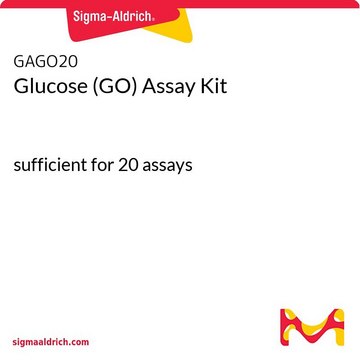MAK312
NADP/NADPH Assay Kit
sufficient for 100 fluorometric tests
Sign Into View Organizational & Contract Pricing
All Photos(1)
About This Item
UNSPSC Code:
12352200
NACRES:
NA.84
Recommended Products
detection method
fluorometric
relevant disease(s)
cancer
storage temp.
−20°C
General description
Pyridine nucleotides play an important role in metabolism and, thus, there is continual interest in monitoring their concentration levels. Quantitative determination of NADP+ /NADPH has applications in research pertaining to energy transformation and redox state of cells or tissue.
Pyridine nucleotides play an important role in metabolism and, thus, there is continual interest in monitoring their concentration levels. Quantitative determination of NADP+ /NADPH has applications in research pertaining to energy transformation and the redox state of cells or tissue.
Features and Benefits
- Sensitive and accurate - Detection limit of 0.01 μM and linearity up to 1 μM NADP+/NADPH in 96 well plate assay.
- Convenient - The procedure involves adding a single working reagent, and reading the fluorescence at time zero and 30 minutes. Room temperature assay.
- High-throughput - Can be readily automated as a high-throughput 96 well plate assay for thousands of samples per day.
Sensitive and accurate - Detection limit of 0.01 mM and linearity up to 1 mM NADP+ /NADPH in 96 well plate assay.
Convenient – The procedure involves adding a single working reagent, and reading the fluorescence at time zero and 30 minutes. Room temperature assay.
High-throughput – Can be readily automated as a high-throughput 96 well plate assay for thousands of samples per day.
Convenient – The procedure involves adding a single working reagent, and reading the fluorescence at time zero and 30 minutes. Room temperature assay.
High-throughput – Can be readily automated as a high-throughput 96 well plate assay for thousands of samples per day.
Suitability
Suitable for measuring NADP+ /NADPH concentrations and ratio in cell or tissue extracts.
Principle
Simple, direct and automation-ready procedures for measuring NADP+ /NADPH concentration are very desirable. This NADP+ /NADPH assay kit is based on a glucose dehydrogenase cycling reaction, in which the formed NADPH reduces a probe into a highly fluorescent product. The fluorescence intensity of this product, measured at λex = 530 nm/λem = 585 nm, is proportional to the NADP+ /NADPH concentration in the sample. This assay is highly specific for NADP+/ NADPH and with minimal interference (<1%) by NAD+ /NADH. This assay is a convenient, direct method to measure NADP+ /NADPH concentrations and ratio in cell or tissue extracts.
The NADP+ /NADPH assay kit is based on a glucose dehydrogenase cycling reaction, in which the formed NADPH reduces a probe into a highly fluorescent product. The fluorescence intensity of this product, measured at lex = 530 nm/lem = 585 nm, is proportional to the NADP+ /NADPH concentration in the sample. This assay is highly specific for NADP+ / NADPH and with minimal interference (<1%) by NAD+ /NADH. This assay is a convenient, direct method to measure NADP+ /NADPH concentrations and ratio in cell or tissue extracts.
Signal Word
Danger
Hazard Statements
Precautionary Statements
Hazard Classifications
Met. Corr. 1 - Resp. Sens. 1
Storage Class Code
8B - Non-combustible corrosive hazardous materials
Flash Point(F)
Not applicable
Flash Point(C)
Not applicable
Regulatory Information
常规特殊物品
Choose from one of the most recent versions:
Certificates of Analysis (COA)
Lot/Batch Number
Don't see the Right Version?
If you require a particular version, you can look up a specific certificate by the Lot or Batch number.
Already Own This Product?
Find documentation for the products that you have recently purchased in the Document Library.
The determination of the redox states and phosphorylation potential in living tissues and their relationship to metabolic control of disease phenotypes.
Veech R L
Biochemistry and Molecular Biology Education, 34(3), 168-179 (2006)
Justin Hou Ming Yung et al.
Cells, 11(3) (2022-02-16)
Oxidative stress caused by the exposure of pancreatic ß-cells to high levels of fatty acids impairs insulin secretion. This lipotoxicity is thought to play an important role in ß-cell failure in type 2 diabetes and can be prevented by antioxidants.
Peng Wang et al.
Advanced science (Weinheim, Baden-Wurttemberg, Germany), 8(19), e2101501-e2101501 (2021-08-10)
The balance between antioxidants and reactive oxygen species (ROS) critically regulates tumor initiation and progression. However, whether and how the tumor-favoring redox status is controlled by cytokine networks remain poorly defined. Here, it is shown that IL-36γ and IL-36Ra reciprocally
Ruilong Liu et al.
Nature communications, 10(1), 991-991 (2019-03-03)
6-Phosphogluconate dehydrogenase (6PGD) is a key enzyme that converts 6-phosphogluconate into ribulose-5-phosphate with NADP+ as cofactor in the pentose phosphate pathway (PPP). 6PGD is commonly upregulated and plays important roles in many human cancers, while the mechanism underlying such roles
Our team of scientists has experience in all areas of research including Life Science, Material Science, Chemical Synthesis, Chromatography, Analytical and many others.
Contact Technical Service


